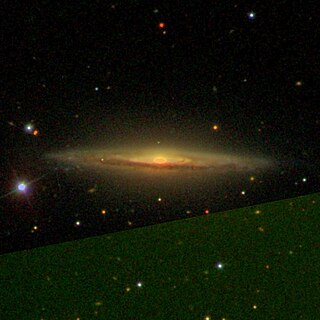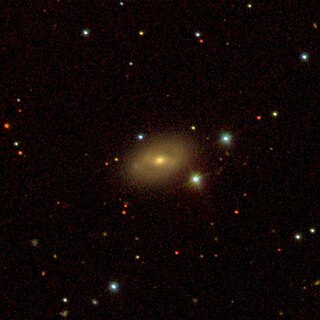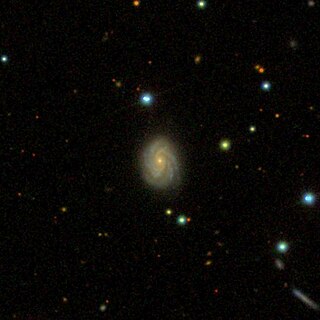
Triangulum is a small constellation in the northern sky. Its name is Latin for "triangle", derived from its three brightest stars, which form a long and narrow triangle. Known to the ancient Babylonians and Greeks, Triangulum was one of the 48 constellations listed by the 2nd century astronomer Ptolemy. The celestial cartographers Johann Bayer and John Flamsteed catalogued the constellation's stars, giving six of them Bayer designations.

Triangulum Australe is a small constellation in the far Southern Celestial Hemisphere. Its name is Latin for "the southern triangle", which distinguishes it from Triangulum in the northern sky and is derived from the acute, almost equilateral pattern of its three brightest stars. It was first depicted on a celestial globe as Triangulus Antarcticus by Petrus Plancius in 1589, and later with more accuracy and its current name by Johann Bayer in his 1603 Uranometria. The French explorer and astronomer Nicolas Louis de Lacaille charted and gave the brighter stars their Bayer designations in 1756.

The Triangulum Galaxy is a spiral galaxy 2.73 million light-years (ly) from Earth in the constellation Triangulum. It is catalogued as Messier 33 or NGC 598. The Triangulum Galaxy is the third-largest member of the Local Group of galaxies, behind the Milky Way and the Andromeda Galaxy. It is one of the most distant permanent objects that can be viewed with the naked eye.

Lampropeltis triangulum, commonly known as the milk snake or milksnake, is a species of kingsnake; 24 subspecies are currently recognized. Lampropeltis elapsoides, the scarlet kingsnake, was formerly classified as the subspecies L. t. elapsoides, but is now recognized as a distinct species. The subspecies have strikingly different appearances, and many of them have their own common names. Some authorities suggest that this species could be split into several separate species. They are not venomous to humans.

Triangulum Minus was a constellation created by Johannes Hevelius. Its name is sometimes wrongly written as Triangulum Minor. It was formed from the southern parts of his Triangula, but is no longer in use. The triangle was defined by the fifth-magnitude stars 6 Trianguli, 10 Trianguli, and 12 Trianguli.

Philanthus triangulum, commonly known as the European beewolf, bee-killer wasp or the bee-eating philanthus, is a solitary wasp that lives in the Western Palearctic and Afrotropics. Although the adults of the species are herbivores, the species derives its name from the behaviour of the inseminated females, who hunt Western honey bees. The female places several of its paralysed prey together with an egg in a small underground chamber, to serve as food for the wasp larvae. All members of the genus Philanthus hunt various species of bees, but P. triangulum is apparently the only one that specialises in Western honey bees.

USS Triangulum (AK-102) was an Crater-class cargo ship commissioned by the US Navy for service in World War II. Triangulum was named after the constellation Triangulum. She was responsible for delivering troops, goods and equipment to locations in the Asiatic-Pacific Theater.
The Borana calendar is a calendrical system once thought to have been used by the Borana Oromo, a people living in southern Ethiopia and northern Kenya. The calendar has been claimed to be based on an earlier Cushitic calendar, developed around 300 BC found at Namoratunga. However, reconsideration of the Namoratunga site led astronomer and archaeologist Clive Ruggles to conclude that there is no relationship. The Borana calendar consist of 29.5 days and 12 months for a total 354 days in a year. The calendar has no weeks but name for each day of the month. It is a lunar-stellar calendar system.
Triangulum II is a dwarf galaxy close to the Milky Way Galaxy. It contains only 1000 stars, yet is quite massive, having a solar mass to light ratio of 3600. This is an unusually high mass for such a small galaxy.
Acarodynerus batchelorensis is a species of wasp in the family Vespidae. It was described by Borsato in 1994.
Acarodynerus denticulatus is a species of wasp in the family Vespidae. It was described by Giordani Soika in 1962.
Acarodynerus legatus is a species of wasp in the family Vespidae. It was described by Giordani Soika in 1977.
Acarodynerus quadrangolum is a species of wasp in the family Vespidae. It was described by Giordani Soika in 1977.
Acarodynerus queenslandicus is a species of wasp in the family Vespidae. It was described by Giordani Soika in 1962.

NGC 684 is a spiral galaxy approximately 135 million light-years away from Earth in the constellation of Triangulum. It was discovered by William Herschel on October 26, 1786. Edward Swift, Lewis' son, found this galaxy again on 18 Jan 1890 while "searching for Swift's Comet." and it was reported as a new object in list IX-6.

NGC 805 is a lenticular galaxy approximately 194 million light-years away from Earth in the constellation of Triangulum. It was discovered by German astronomer Heinrich Louis d'Arrest on September 26, 1864 with the 11-inch refractor at Copenhagen.
NGC 592 is a H II region type emission nebula located in the Triangulum galaxy (M33) and thus in the constellation of Triangulum. The nebula contains an open cluster of stars and is approximately 2.86 million light-years away from Earth.

NGC 819 is a spiral galaxy approximately 302 million light-years away from Earth in the constellation of Triangulum. It forms a visual pair with the galaxy NGC 816 5.7' WNW.

NGC 860 is an elliptical galaxy located in the constellation Triangulum. It is about 410 million light-years from the Milky Way. It was discovered by the French astronomer Édouard Stephan in 1871.










